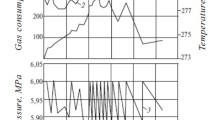Abstract
The effective thermal conductivities of gas-saturated porous methane hydrates were measured by a single-sided transient plane source (TPS) technique and simulated by a generalized fractal model of porous media that based on self-similarity. The density of porous hydrate, measured by the volume of the sample in the experimental system, was used to evaluate the porosity of methane hydrate samples. The fractal model was based on Sierpinski carpet, a thermal-electrical analogy technique and one-dimensional heat flow assumption. Both the experimental and computational results show the effective thermal conductivity of methane hydrate decreases with the porosity increase. The porosity of 0.3 can reduce the thermal conductivity of the methane hydrate by 25%. By analysis of the experimental data and the simulative result, the optimized thermal conductivity of the zero-porosity methane hydrate is about 0.7 W m−1 K−1.
Similar content being viewed by others
References
Sloan ED. Clathrate Hydrates of Natural Gases. 2nd ed. New York: Marcel Dekker Inc., 1998
Huang DZ, Fan SS. Thermal conductivity of methane hydrate formed from sodium dodecyl sulfate solution. J Chem Eng Data, 2004, 49: 1479–1482
Li XS, Zhang Y, Li G, Chen ZY, Yan KF, Li QP. Gas hydrate equilibrium dissociation conditions in porous media using two thermodynamic approaches. J Chem Thermodyn, 2008, 40: 1464–1474
Tang CP, Dai XX, Du JW, Li DL, Zang XY, Yang XY, Liang DQ. Kinetic studies of gas hydrate formation with low-dosage hydrate inhibitors. Sci China Chem, 2010, 53: 2622–2627
Kuhs WF, Klapproth A, Gotthardt F, Techmer K, Heinrichs T. The formation of meso- and macroporous gas hydrates. Geophys Res Lett, 2000, 27: 2929–2932
Rosenbaum EJ. Thermal Properties and Characterization of Methane Hydrates. M.S. thesis, University of Pittsburgh. 2003
de Martin BJ. Laboratory Measurements of the Thermal Conductivity and Thermal Diffusivity of Methane Hydrate at Simulated in situ Conditions. M.S. Thesis, Georgia Institute of Technology, 2001
Gupta A, Kneafsey TJ, Moridis GJ, Seol Y, Kowalsky MB, Sloan ED Jr. Composite thermal conductivity in a large heterogeneous porous methane hydrate sample. J Phys Chem B, 2006, 110: 16384–16392
Thovert JF, Wary F, Adler PM. Thermal conductivity of random media and regular fractals. J Appl Phys, 1990, 68: 3872–3883
Adler PM. Transports in fractal porous media. J F Hydrology, 1996, 187: 195–213
Ma YT, Yu BM, Zhang DM, Zou MQ. A self-similarity model for effective thermal conductivity of porous media. J Phys D: Appl Phys, 2003, 36: 2157–2164
Zhao YL, Guo KH, Liang DQ, Fan SS, Liu XC, Shu BF, Ge XS, Liu Y. Formation process and fractal growth model of HCFC-141b refrigerant gas hydrate. Sci China Ser B, 2002, 45: 216–224
Yang HJ, Li XS, Chen ZY, Yan KF, Li G., Huang NS. Study on the dissociation behavior of gas hydrate in porous sediment based on fractal theory. Acta Chimica Sinica, 2009, 67: 808–812
Mandelbrot BB. The Fractal Geometry of Nature. New York: WH Freeman and Company, 1982
Hsu CT, Cheng P, Wong KW. A lumped-parameter model for stagnant thermal conductivity of spatially periodic porous media. J Heat Transfer, 1995, 117: 264–269
Yu B, Chen P. Fractal models for the effective thermal conductivity of bi-dispersed Porous media. J Thermophys Heat Tr, 2002, 16: 22–29
Chen SX. Thermal conductivity of sands. Heat Mass Transfer, 2008, 44: 1241–1246
Carson JK, Lovatt SJ, Tanner DJ, Cleland AC. Experimental measurements of the effective thermal conductivity of a pseudo-porous food analogue over a range of porosities and mean pore sizes. J Food Eng, 2004, 63: 87–95
Kaye GWC, Laby TH. Tables of Physical and Chemical Constants. 16th ed. Middlesex: National Physical Laboratory, 2007. (available at http://www.kayelaby.npl.co.uk)
Stern LA, Kirby SH, Circone S, Durham WB. Scanning electron microscopy investigations of laboratory-grown gas clathrate hydrates formed from melting ice, and comparison to natural hydrates. Am Mineral, 2004, 89: 1162–1175
Waite WF, Pinkston J, Kirby SH. Preliminary laboratory thermal conductivity measurements in pure methane hydrate and methane hydrate-sediment mixtures: A progress report. In: Proceedings of 4th International Conference on Gas Hydrates. Yokohama, Japan. 2002. 728-733
Rosenbaum EJ, English NJ, Johnson JK, Shaw DW, Warzinski RP. Thermal conductivity of methane hydrate from experiment and molecular simulation. J Phys Chem B, 2007, 111: 13194–13205
Kumar P, Turner D, Sloan ED Jr. Thermal diffusivity measurements of porous methane hydrate and hydrate-sediment mixtures. J Geophys Res, 2004, 109: B01207, doi: 10.1029/2003JB002763
Author information
Authors and Affiliations
Corresponding author
Rights and permissions
About this article
Cite this article
Li, D., Du, J., He, S. et al. Measurement and modeling of the effective thermal conductivity for porous methane hydrate samples. Sci. China Chem. 55, 373–379 (2012). https://doi.org/10.1007/s11426-011-4459-8
Received:
Accepted:
Published:
Issue Date:
DOI: https://doi.org/10.1007/s11426-011-4459-8




